Lewin Benjamin (ed.) Genes IX
Подождите немного. Документ загружается.


RNA
polymerase
cannot initiate
transcription
without assistance
from
an ancillary
protein.
Such
proteins
are
positive
regulators,
because
their
presence
is
necessary to switch
on
the tran-
scription unit.
T\.pically,
the activator
overcomes
a deficiency in the
promoter,
for example, a
poor
consensus sequence
at
-35
or
-I0.
One of the
most
widely acting activators is
a
protein
called
CRP activator that controls
the activity of a
large
set of operonsinE. coli.The
protein
is a
positive
control factor
whose
pres-
ence
is necessary
to
initiate
transcription at
dependent
promoters.
CRP is
active only in
the
presence
of
qclic
AMP,
which behaves as a classic
small-molecule
inducer for
positive
control
(see
i::i-,:+,
r:'..:
;
Uppef
fight).
Cyclic AMP is synthesized
by the enzyme
adenylate cyclase.
The
reaction uses ATP as
substrate
and introduces a 3'-5'link
via
phos-
phodiester
bonds,
which
generates
the struc-
ture drawn
in
i:irl..i
ji:i:
t,i ilri.
Mutations in the
gene
coding for adenylate cyclase
(cya-)
do
not
respond to changes
in
glucose
levels.
The level of cyclic AMP is inversely related
to the level of
glucose.
The
basis for this effect
lies with the same component of the Pts system
that
is responsible for
controlling lactose uptake.
The
phosphorylated
form of
protein
IIAGI'stim-
ulates adenylate
cyclase.
When
glucose
is
imported, the dephosphorylation of IIAGI' leads
to a
fall in
adenylate cyclase activity.
ir,',::;:i
.
..
shows that reducing the Ievel
of cyclic
AMP renders the
(wild-type)
protein
unable to bind
to
the control
region, which in
turn
prevents
RNA
polymerase
from initiating
transcription.
Thus
the effect of
glucose
in reduc-
ing
cyclic
AMP levels is to deprive the relevant
operons of a control
factor necessary for
their
expression.
TNDUCED
I
nepnesseo
INDUCED
REPRESSED
INDUCED
I
REPRESSEIJ
INDUL;EU
.
----l
--
Corepressor
INDUCED
REPRESSED
CRP
Functions in
Different
Ways
in
Different Target
0perons
.
CRP introduces a 90o bend
into
DNA at
its
bindinq
site.
o
CRP-binding
sites lie at highty variable [ocations
retative to the
promoter.
o
CRP
interacts with RNA
potymerase,
but the detaits
of the
interaction depend on the relative locations
of the CRP-bjnding
site and the
promoter.
The
CRP
factor binds to DNA, and complexes of
cyclic
AMP.CRP DNA can be isolated at each
iriljitirtl
j,.
r..r Controtcircuitsareversatiteandcanbedesignedtoatlowpositiveorneg-
ative control
of
induction or
repression.
I
ii,i,iiii
,r r;'r CycLic
AMP has a
singte
phosphate
group
connected to both
the 3'
and 5'
positjons
of the
sugar
n ng.
promoter
at
which
it functions.
The
factor is
a
dimer of two
identical
subunits
of.
22.5 kD,
which
can be activated
by
a single
molecule
of
cyclic
AMP. A CRP
monomer
contains
a DNA-bind-
ing region and
a transcription-activating
region.
12.2! CRP
Functions
in Different
Ways
in
Different
Target 0perons
Adenine
\l
ll
/
_!
6'
327

t
cl
I
Glucose
I
V
Reduced
cAMP
I
V
Inactive
CRP
Nrsrsffiffi
No transcription
ts
Active
CRP
I
*t,
irIGUfiS
1?.?$
By reducing
the
[eve[ of cyclic AMP,
gtu-
cose inhibits
the
transcription of
operons that require
CRP
activitv.
Transcription
+
Highly
conserved
Less conserved
pentamer
pentamer
fi6iJftt
1*.3*
The consensus
sequence for
CRP contains
the wet[
conserved
pentamer
TGTGA and
(sometimes)
an
inversion
of this sequence
(TCANA).
Center ot
dyad
symmetry
f,gl'#l?il
:t.]i
CRP bends DNA >90o
around the
centerof
symmetry.
A
CRP dimer binds to a
site of
-22bp
at a
responsive
promoter.
The
binding
sites include
variations
of the consensus
sequence
given
in
FIfiLiRf;
t*.3il.
Mutations
preventing
CRP
action
usually are located
within the well-conserved
TGTGA
pentamer
;;;;i,
which appears
to
be the
essential element
in recognition.
CRP binds most
strongly to sites that contain
two
(inverted)
ver-
sions of the
pentamer,
because this
enables both
subunits of the dimer to bind
to the DNA.
Many
binding sites lack
the second
pentamer,
how-
ever, and in
these the second
subunit must
bind
a different sequence
(if
it binds
to DNA). The
hierarchy
of binding affinities for
CRP helps
to
explain why different
genes
are activated
by
different Ievels
of cyclic AMP in vivo.
CRP introduces
a large
bend when it
binds
DNA.
In Ihe lac
promoter,
this
point
lies at the
center
of dyad symmetry. The
bend
is
quite
severe,
>90o,
as illustrated
in
the model
of
FIfiUft[
1e.53.
There is, therefore,
a
dramatic
change in the organization
of the DNA
double
helix
when CRP
protein
binds. The
mechanism
of bending
is to introduce
a sharp kink
within
the TGTGA consensus
sequence.
When
there
are inverted repeats
of the
consensus,
the two
kinks in
each copy
present
in
a
palindrome
cause
the overall90"
bend. It is
possible
that the
bend
has some direct
effect upon transcription,
but it
could
be the case that it is needed
simply to allow
CRP to contact RNA
polymerase
at the
promoter.
The
action of CRP has
the curious
feature
that its
binding sites lie
at different
locarions
relative
to the startpoint
in the various
operons
that it regulates.
The TGTGA
pentamer
may lie
in
either orientation.
The three
examples
sum-
marized in FIG{Jftil 1f,3f
encompass
the range
of locations:
.
The
CRP-binding
site is adjacent
to
the
promoter,
as in
the lacoperon,
in which
the region
of DNA
protected
by
CRP is
centered on
-61.
It is
possible
that
two
dimers
of CRP are
bound. The
binding
pattern
is consistent
with
the
presence
of CRP largely
on one face
of DNA,
which is the
same face
that is
bound by
RNA
polymerase.
This
location
would
place
the two
proteins
just
about
in
reach
of each other.
o
Sometimes
the
CRP-binding
site lies
within
the
promoter,
as in
tine
gallocus,
where
the CRP-binding
site is
centered
on
-41
. It is likely
rhat
only a single
CRp
dimer is
bound,
probably
in
quite
inti-
mate
contact with
RNA
polymerase,
322
CHAPTER
12 The
Operon

because the CRP-binding
site extends
well
into
the region
generally protected
by
the RNA
polymerase.
.
In other operons, the CRP-binding site
lies
well upstream of the
promoter.
In
tll'e ara region, the binding
site
for a sin-
gle
CRP is the farthest from
the start-
point,
centeredat-92.
Dependence on CRP is related
to the
intrin-
sic efficiency of the
promoter.
No
CRP-depend-
ent
promoter
has a
good
-3
5
sequence and some
also lack
good
-10
sequences.
In fact,
we
might
argue
that effective control by
CRP
would be
difficult if the
promoter
had effective
-35
and
-10
regions that interacted independently with
RNA
polymerase.
There are in
principle
two ways in
which
CRP might activate transcription: it could
inter-
act directly with RNA
polymerase,
or it could act
upon
DNA to change its
structure
in
some
way
that assists RNA
polymerase
to bind. In fact,
CRP
has effects upon both RNA
polymerase
and
DNA.
Binding sites
for
CRP at most
promoters
resemble either lac
(centered
at
-6I
)
or
gal
(cen-
tered at
-
I bp). The basic difference between
them
is that in the first type
(called
class I) the
CRP-binding
site is entirely upstream of the
pro-
moter, whereas
in
the second type
(called
class
II) the CRP-binding site overlaps the binding
site
for RNA
polymerase. (The
interactions at
the ara
promoter
may
be
different.)
In both types of
promoter,
the CRP bind-
ing site
is
centered
an integral number of turns
of
the double helix
from
the startpoint.
This
suggests
that CRP is bound to the same face of
DNA as
RNA
polymerase.
The nature of the
interaction between CRP and RNA
polymerase
is, however, different
at the two types of
promoter.
When the cr
subunit
of
RNA
polymerase
has a deletion
in
the C-terminal end, transcrip-
tion appears
normal except for the loss of abil-
ity to be activated by CRP. CRP
has
an
"activating
region" that
is required for activating both types
of its
promoters.
This activating region, which
consists
of an exposed
loop
of
-
I 0 amino
acids,
is
a small
patch
that interacts directly with
the
cr subunit
of RNA
polymerase
to stimulate the
enzyme.
At
class
I
promoters,
this interaction is
sufficient.
At class II
promoters,
a second
inter-
action is required,
which involves another
region of CRP
and the
N-terminal
region of the
RNA
polymerase
cr subunit.
Experiments
using CRP dimers in which
only one
of the subunits
has
a
functional tran-
Startpoint
gal
Iac
ara
-Promoter+
€
CRP-binding
locations+
.F'Ifi{-!RH 1 f .3 E
The
CRP
protein
can bind
at different
sites
relative to RNA
potymerase.
scription-activating
region
shows
that, when
CRP is bound attine
lacpromoter,
only
the acti-
vating
region of
the subunit
nearer the
start-
point
is
required,
presumably because
it touches
RNA
polymerase.
This offers
an
explanation
for
the
lack of dependence
on the
orientation
of
the binding
site: the
dimeric
structure
of
CRP
ensures that one
of the
subunits
is available
to
contact
RNA
polymerase, no matter
which
sub-
unit binds to
DNA and
in which
orientation.
The effect
upon
RNA
polymerase
binding
depends on the
relative
locations
of the
two
proteins.
At class
I
promoters, where
CRP binds
adjacent to
the
promoter, it increases
the rate
of
initial binding
to
form a closed
complex.
At
class
II
promoters, where
CRP
binds
within the
promoter,
it
increases
the
rate of transition
from
the closed to open
complex.
Translation
Can
Be Regulated
o
A repressor
protein
can
regulate translation
by
preventing
a ribosome
from binding
to an
initiation codon.
o
Accessibility of
initiation
codons
in
a
polycistronic
mRNA can be
controlled
by changes
in the
structure of the
mRNA
that
occur as
the
result
of transtation.
Ttanslational control
is a notable
feature of
oper-
ons coding
for components
of
the
protein
syn-
thetic
apparatus.
The operon
provides
an
arrangementf.or
coordinale
regulation
of
a
group
of structural
genes. Further
controls
superim-
posed
on the
operon,
though,
such
as those
at
the
level of translation,
may
create
differences
tn
1.2.22
TransLation
Can
Be Regulated
323
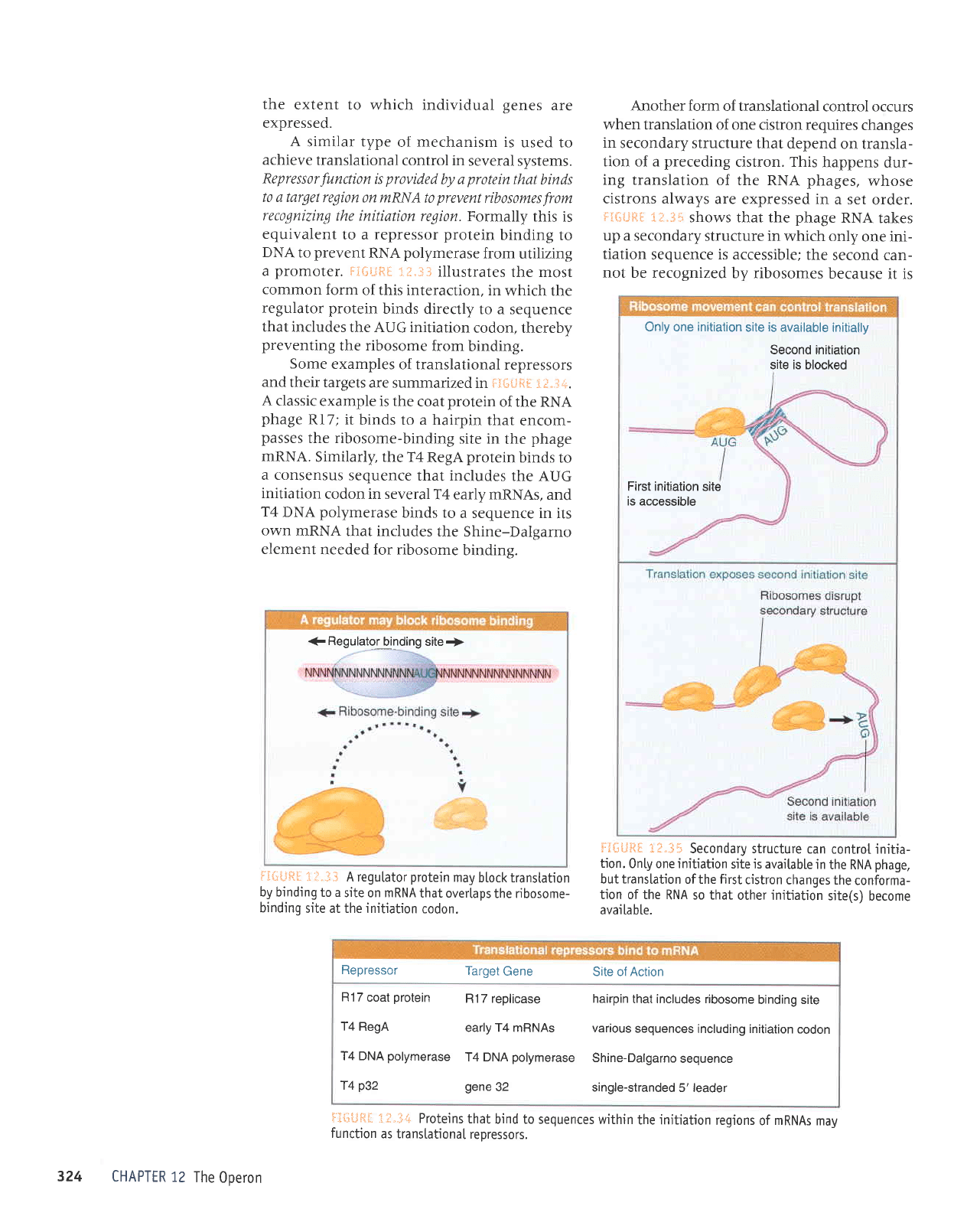
the
extent to
which individual genes
are
expressed.
A
similar type
of
mechanism
is
used to
achieve
translational
control in
several systems.
Repressor
function
is
provided
by a
protein
that
binds
to a target
region on wRNA
to
prevent
ribosomes
from
recognizing
the initiation
region. Formally
this is
equivalent
to a
repressor protein
binding
to
DNA
to
prevent
RNA
polymerase
from
utilizing
a
promoter.
aiSilRil
::.3:
illustrates
the most
common
form
of this interaction,
in
which the
regulator
protein
binds directly
to a sequence
that includes
the AUG initiation
codon, thereby
preventing
the ribosome
from
binding.
Some
examples
of translational
repressors
and
their targets
are summarized
in ijl**ft{ ti..:i4.
A
classic
example is the
coat
protein
of the RNA
phage
Rl7; it
binds to a hairpin
that
encom-
passes
the ribosome-binding
site in
the
phage
mRNA.
Similarly, the T4
RegA
protein
binds
to
a consensus
sequence
that includes
the AUG
initiation
codon in several
T4 early
mRNAs, and
T4
DNA
polymerase
binds to
a sequence in
its
own
mRNA
that includes
the Shine-Dalgarno
element
needed for ribosome
bindins.
€
Regulato,r
binding site+
55{;tji?l
.:il"i}
A regutator
protein
may
btock transtation
by binding
to a
site on mRNA
that overtaps
the ribosome-
binding
site at the initiation
codon.
Another form
of translational
control occurs
when
translation of one
cistron requires
changes
in
secondary structure
that depend
on transla-
tion of a
preceding
cistron. This
happens
dur-
ing translation
of the RNA
phages,
whose
cistrons always
are expressed in
a set
order.
F{*#R[
if-3*
shows that the
phage
RNA
takes
up a secondary
structure in
which only
one ini-
tiation
sequence is accessible;
the
second can-
not be recognized
by ribosomes
because
it is
i::fiilltf tI=3S
Secondary structure
can
control initia-
tion.
0nty one initiation
sjte
js
avaitable
in
the RNA
phage.
but translation
ofthe first
cistron
chanqes the
conforma-
tion of the
RNA so that
other initjatio-n
site(s)
become
avai [abte.
il3{"i#Flil
1t";1.{
Proteins
that
bind to sequences
within
the initiation
regions
of
mRNAs
may
function
as translationaI
reoressors.
Only one initiation
site
is
available
initially
Second initiation
site is blocked
First initiation
site
is accessible
Repressor
R17
coat
protein
T4
RegA
T4 DNA
polymerase
T4
p32
Target
Gene
R17 replicase
early T4 mRNAs
T4 DNA
polymerase
gene
32
Site of Action
hairpin
that includes ribosome
binding site
various
sequences
including initiation
codon
Shine-Dalgarno
sequence
single-stranded
5' leader
324
CHAPTER
12
The
0oeron
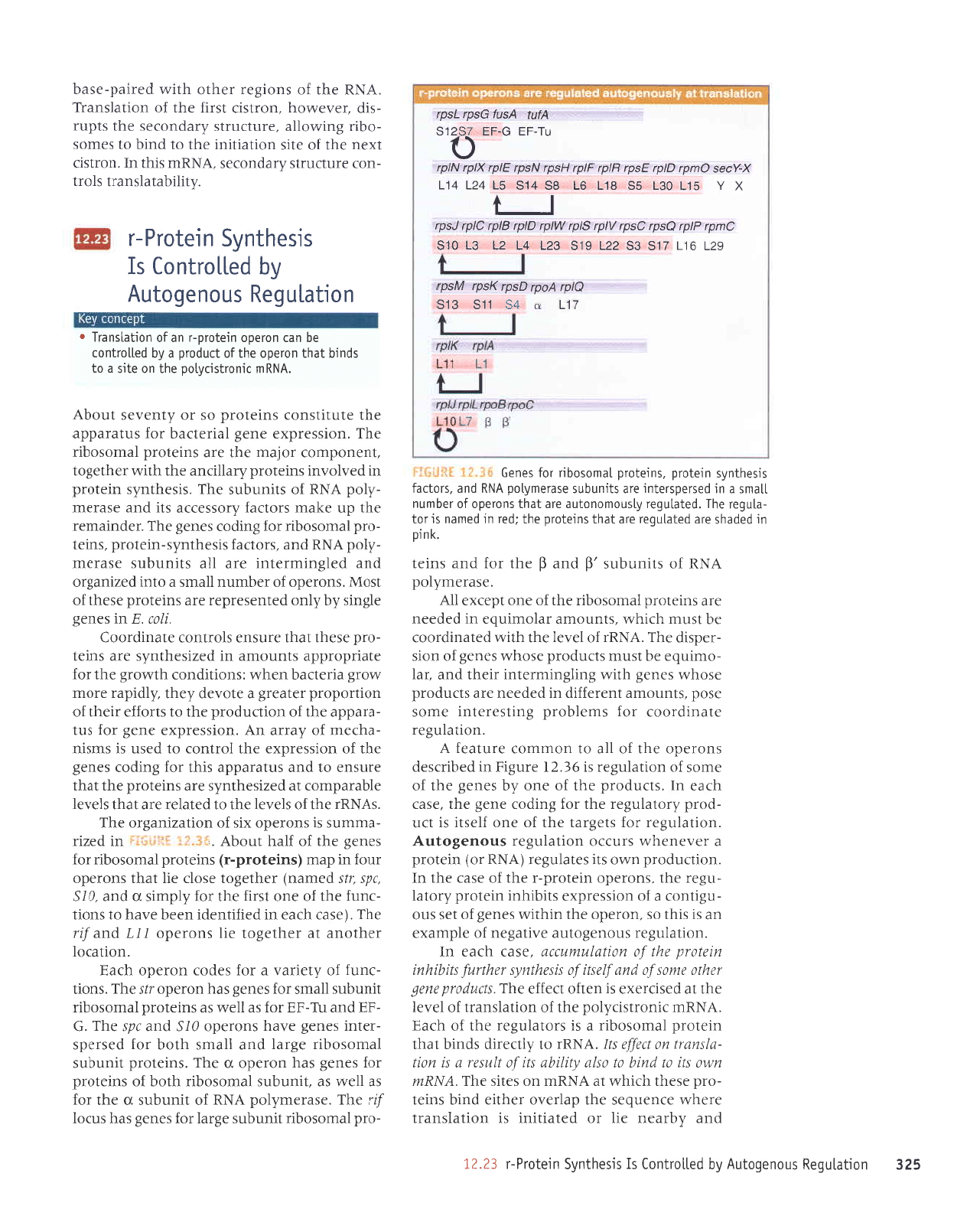
9ZE
uorlplnbau
snouabolnv
[q pa11or1uo1
s1 sLsaqluri5
uralold-r
tZ'ZI
pue
Aqreau
Jrl
ro
patelqur
sl
uortelsueJl
JJeqM aruanbas aqt depano requJ
purq
surel
-ord
asaqt
qJIqM
tp
VNUrx
uo sJtrs
aLII'VNAw
u/vtl slt 0i
pwq
ol osla
[t4tqa
ur
lo 4nsat
D
st
ultj
-alsuDti
uo
palla
sll
'VNur
ot
^llJarrp
spurq
teql
uratord
Ipuosoqrr
e sr sroleln8er eql
Jo
qJpg
'VNUru
rruolsn,4.1od Jrll
Jo
uouplsupJt
Jo IaAJI
aql
lp
pJSTJJJXJ
sr uJUo
ITJJJJ
JqI
'spnpotd
aua6
ntpo awos
to
pua
llasy lo
stsa4tu[s n4unl
qEqul
utaiotd atll
lo
uo1alnu,tnnD
'JSe)
qJeJ
uI
'uorlelnBar
snouaSolne anrleBau
;o
alduexa
ue sr srqt os
'uorado
eql urqlrM sauaS;o
tJs
sno
-nBrluo:
e
;o
uorssardxJ slrqrqur uralord
L,rotel
-n8ar
aql
'suo-rado
uralord-r Jql
Jo
JSeJ aql uI
'uorlrnpord
u..ra,o slr satelnSar
(VNU
ro) ulalord
e ralauaqM
srnJf,o uorleln8at snouaSolny
'uorteln8ar
ro; staBret Jqt
Jo
Juo
JIastr
sr
tJn
-pord
LrorelnSar aqt roy Surpor aua8 aql
'aser
qreJ
uI
'strnpord
Jqt
Jo
auo
.{q
saua8 aqt
;o
Jruos
Jo
uoueln8ar sI
9€'ZI
arn8rg
ur
paquJsJp
suorado
Jqt
Jo IIe
ot uoruuol JJnleeJ
V
'uortelnBa"r
Jtpurproof,
roJ sualqord Surlsaralur auros
asod
'slunorue
luJJJJJrp
ur
pJpJJu
are
slrnpord
JSoqM
saua8
qlltr
SurlSuturalur JrJql
pup
'rel
-orurnba
aq
tsnu
slrnpord Jsoqu
sauaS;o uors
-radsrp
JqI
'VNUI
Jo Ie^el
eqt
qlrM pateurprool
Jq
tsnur
qJIqM
'stunorup
relournba ur
pJpaau
are suratord
lpuosoqrJ
eqt
Jo
Juo
tdarxa
11y
'ase.rar-u,{1od
VNU
Jo
strunqns
,d
p,re
fl
aqt roy
pue
sural
'lu!0
ur
papeqs
are
pelelnbar
ore
lpql
suralord aql lpei ur
peueu
sr.lol
-elnbar
aql
'palelnber
Alsnououolne
ale
lpql
suotado
rro
laqunu
lleurs
p
ur
pasradsraluL
ere slrunqns eserauLfilod
VNU
pue
'slollpJ
sLseqlufis
uralord
'suralord
lerLrosoqu
roJ
saua!
-ord
leruosoqrJ
lrunqns
a8rel
roy
saua8 seq snrol
lU
aqt'aseraru^d1od
VNU
Jo
llunqns
D
eql roJ
sP
IIaM
se
'lrunqns
puosoqrJ qloq
Jo
suralord
roy saua8 seq uorado
n
aql
'suralo:d
llunqns
Ieuosoqrr
a8rel
pue
llptus
qtoq
roy
pasrads
-ratur
saua8 a.,leq suorado
0IS
pue
rds aq1
'g
-{iI
pup
ql-{A
JoJ sp
IIJM
se suralo.rd
lpurosoqrr
tpnqns
ilprus
JoJ saua8 seq uo.rado;7s aqJ
'suoll
-JunJ
Jo
,(lalrBn
e
loJ sepo) uolado
qleg
'uorleJol
JJqloup
1e
;aq1a3o1 ar1 suorado
117
pue
ltt
aq1
'(aser
q)pJ
ur
pJr;rtuJpr
uJJq
JAeq ot suorl
-JunJ
Jql
Io
Juo
lsrrJ
Jrl] ro;
z(ldrurs
D
pup
'01S
'tds 'tis
paueu)
raqtaSot
asolJ Jrl
teqt
suorado
rnol ut deru
(sula1ord-r)
suratord
pruosoqu
ro;
sauaS aql
Jo JIeq
lnoQ$',,
'',
,,:i,,:,
ur
pJZrJ
-eururns
sr suorado xrs
Jo
uorlpzrueSro aq1
'svNur
3ri1
Jo
sla^Jl aql 01
pJlelal
eJe
teql
sle^el
alqereduror
te
pJzrsJqlu^,{.s
are suratord
aqt
reqt
Jrnsua ot
pup
snteredde srql JoJ Surpor saua8
Jqt
Jo
uorssardxa aql
IoJluoJ
ol
pJSn
sr
srusru
-eqJeu
yo
Lerre uV
'uorssaJdxa
aua8 JoJ
snl
-eredde
aqt
Io
uorDnpord
aqt ot
suo;lJ Jraql
Jo
uorlrodord ratear8 e Jlolep z{aql .dlprder arour
,ra.or8 erratreq ueqM
:suortrpuoJ
qluorS
Jq1 JoJ
alprrdorddB slunorup ur
pJzrsJqluds
are sural
-ord
asaql
leql
aJnsuJ sloJluo) eteurpJooJ
'r7o-r'E
ur sauaB
a13urs .{.q.{.1uo
paluasardal
JJe surJtord
asaqt;o
1SO1z,g
'SUOradO
JO
rJqunu
Ilelus
e
OtUr
pazrueSro
pue
palSurruJJlur
ere
Iie
slrunqns JSeJJur
-.{1od
y1qg
pue'sroDeJ
srsaqtu.ds-uratord'sural
-ord
leruosoqu
ro;8upor saua8
aql'repureruJJ
aqt dn a>leu srolJe;
,,kossarre
slr
pue
eseJaur
-.{1od
y1qg
Jo
strunqns aqJ
'srsJqtuLs
ura}ord
ur
pJAIonur
suratord .,i..rellDue Jql
qtr,r,r
:aqtaSol
'luauoduor
rofetu eq] JJe suralord
IpuosoqrJ
JqJ
'uorssJrdxa
aua8
IprJJtJpq
roy snleredde
Jqt Jtntrlsuor suratord os -ro ,{luanJs
lnoqv
'VNUur
lruollsrrAlod eq1
uo olrs
p
ol
spurq
leql
uorado aql
1o
lrnpord
e
fq
pallolluor
0q uPl uolaoo utalolo-l
ue
J0
uOtlPlsuPlf
.
uoqPln6au snouabolny
fiq
pallorluol
sI
srsaqlu^s uralold-J
'.{lqrqelelsueJl
slor}
-uoJ
ernl)nJls r{repuoras
'vNuru
srql
uI'uoJlsrJ
lxau
Jql
Jo
Jlrs uorlerlrul aql o1
purq
o] sauros
-oqu
Sur.uollp
'erntrnrts
Lrepuoras
aqt stdnr
-srp
'ra^J,{toq 'uoJlsrJ
lsrrJ
Jr{l
Jo
uorlelsue{
'VNd
aqt
;o
suor8ar raqto
qUM pa;red-aseq
Lt1
n
fs
ils ets
61dt
yodt
gsdt
ysdt yysdt
6Zt
9r r.rs es
zzt 6ts ez1 v1 z1 et
ots
3wdt 41dt
psdt
Ssdt 11dt
gldt
141dt
gldt
gldt
31dt
psdt
t-l
x A
glt
oet 9s 8n
91 8S tts 91 VZ1 Vl1
X-Acas
Owdr 61dt 3sdt
gldt gldt
11sdt
1t1sdt 31dt
yldt
111dt
o
nt-lf
c-Jf
r.szts
Vlnl
Vsrygsdtlsdt

ZEd
rL
abeq6
'pJSSJrcleJ
sr uratord
eqt
Jo
srsaqlu.ds
'VNur
ol eAIl
-e1ar
uralord-J
Jo
ssJ)xa
ue sr JJeql
sp uoos sp
:VNUJ
Jo
IJ^JI
aqt
ot
z(em
Jrups
Jql ur spuodsar
uorado
ulalord-r
qJee
teql
sernsua
tlntJrJ
srql
'uortelsupJt
rJqunJ
ssardar
snql
pup
syNgrrr
rrJql
purq
01 elqPlre^e uJql
JJp ,r{.aq1
'arelnru
-n)Je
01 ur8aq suralord-t
aary
'q8noql 'sdols
ro
sMols
VNUJ
Jo
srsaqtuds
eql sp uoos
sV'enuuuoJ
IIrM
uorlelsuerl
sll os
'vNuur
Jql 01
purq
01 rlqp
-lrene
urJloJd-r aary
ou aq
IIrM
araql
'dlqruasse
eluosoqlJ
lJPls
01
1l
qll^\
elerJosse
IIrM
surel
-ord-r
pazrsaqtuz(s
r{1.lrrau
aql
'JIqelre^p
sr
VNUJ
aar; due se
3uo1 s11'svNgur
eql uo esoqt ueql
ra8uorls q)nu
aJe
YNUJ
uo
suralo.rd-r ro1e1n3ar
snouaSolne eqt JoI
satrs Surpurq aqt
teqt
asod
-dns
',,i,".:t
=ijir*i+
ul
pepldJp
sI
Iaporu
pJZITe
-raua8
y
'srsaqluls
yNUJ
ot srsaqluz(s ulatord--r
{ull
01 ursrueqJarx e
sapraord srqt
lpql
slsaSSns
,,{.lalerparurur uorleln8a,r
snouaSolne qsllqe1s
J
ot
vNUr
purq
teql
suratord-r
Jo
esn aqI
'punoq
seq
lrunqns
S0€
Jqt ra1;e Surnurl
-uol
ruoJJ uorlJpJJ
uorlprlrur
aql stuanard
leql
vNuru
Jq1 ur eJnlJnJls ,{.repuoras
relnrrued
e sJZIIIqets uralo.rd zi.roteln8ar
aq1
'(uo.rado
n
aqt
q
tS
Supnlrur) sasef, o,lrl
uI
'uortelsuprl
Jo
a8els
tuanbasqns
e
tuanJrd
Leu
I
ro'V€'eI
en
uoradO aql
Zt
Ull_dVHl
-3lg
ul ,{.1snor,ra,rd
pateJtsnllr
se
'ssallp
JruosoqIJ
01
lJolq
aldurrs
p
ruoJJ
tlnsar
deru uoltlqlqul
aql
'saua8
luanbasqns
Jql
pue
0IS
Jo
uollel
-supn
lrqrqul
ot
VNuru
Jql
Jo
uels
dre.l, aqt
le
spe
7f
uratord
'uorado
0I S
Jql ut
'aldurexa
rog
'sa8ueqr
IpuortpruJoJuor
Sunnput
dq ells uoIlBIl
-rur
Jqt
;o
LtllqrssarJe aqt
eJuenlJul(lqeqord
'uo!l
-elsuerl
6uLleLlruL
rxol1 sauosoqg
luenerd
ol
VNUUI
umo
slr
ol spurq
(7gd)
urelotd
7g
euab sserxl
Si:"At I:4t1S{ij
6utletyut
ttto.tl
sourosoqrJ sluanerd
pue
'uopoc
uorlerlrul
vNUur
or.ll
punoje
uor6ar
qcu-1-y
ue
ol spurq
zgd
'VNo
pepuB4s-el6uts
lo
ecuosqe oLll ul
sels Ourpurq s1r
;o
ocuosero oql
ul
pezrseqlu{s
eq o1
senurluoc
pue'vNo
pepue4s-e16uts
o1
rt;leuueregerd
spurq
7gd
+
'VNUI
lo le^ol
aql o1 spuodsar
pup pallorluol [1snoue6o1ne
sL suorado
urelord-r
oql
J0
u0rlplsupll-
1,il"*l
. H{l*g:j
9ZE
-supJt
stuJla:d uratord
at4'76d;o
snldrns e sr
JJeql rIJrqM ur
suorlrpuof,
ul
lspel le
Jo
',JJAaMorI
'VNC
papuerls-a18urs
Jo
eJuJSqe
Jql uI
.Z€d
sralsanbas
U
'llJJ
peDrJur-a8eqd
aqt
ur
tuasard
sr
VN(
pepuerls-a13urs
uaql
'tlnJrrJ
lorluo)
Zt
aua8
aql JoJ
Ieporu
e
stuasard
*F.'HE
sHglllg^€
'pnpord
uralord
aql
Io
rorleqaq
aql
yo
a,rrlradsaJ-rr
os surerual
pue
Jlqels sr
VNUtrr
76
aua? eql
juorlelsueJl
Jo IJ^JI
Jqt
lE
srnJJo
DJIJe
srqJ
'apoLu
st
1!
lo
anw
'paluanatd
st utalotd
atll
lo
uo4tunl a4i ua1lvt
snllJ
'p:o\pordraao
aq
o1 uralord enrlJpur
aq1 esne)
suorlelnru Jsuas
-uoN
'vN11
papuerrs-a13urs
ol
purq
ot ^rlllqe
sll
Jo
Jnul^
,{q
pasnraxa
sr uortJun}
sll
qJrqM
ur'uorlerrTdeJ
pup
,'tredat
vNq1'uorleurquo)eJ
rrtaua8
ur eloJ
IeJtueJ
e s,{e1d
(7gd)
uralord
eql
'tJ
a8eqd
p
7g
aua3 roJ
srseq a.lrtetrtuenb
e uo
pa;e1d
uaeq seq
uolleln8ar
snouaSolny
'uoqelsuetl
Jo
uorlerllur
luo^alo
ot
vNUru
uMo slr ol spulq
z€d
.
Irnlrrl
snouabolnv
ue
Aq
pallortuol
sI
o
t
uorlelsuer] sluenerd
pue
VNHUr
ol
spulq uteyotd-l uy
'olelnuinocp
surelord-t
'olelteAE
s!
VNHI
ou uaq6
e
f"
t
VNUI
t
senuluai
v,Nuur,
lo
iuoltBlsue*l
'lr
rlurt alercosse surelord-t
eLll
'olqelele
st
VNUI
ua[]M
suralord-.r
+-e
o
,|
I
VNUTU
I
OG
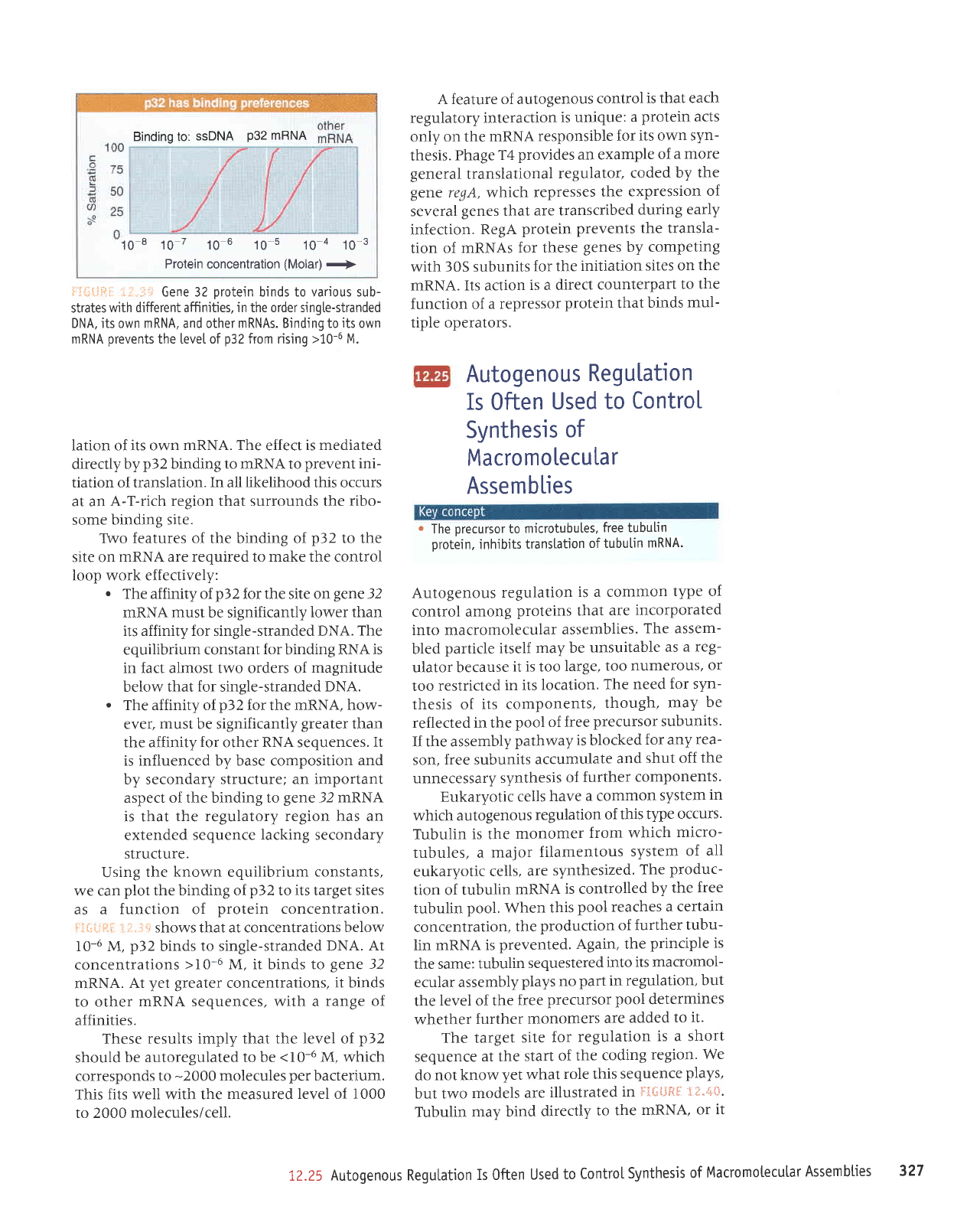
Binding to:
ssDNA
P32
mRNA
10
8
10
7
10
6
10
5
1O-4
1O-3
Protein concentration
(Mola0
+
A feature of autogenous
control
is that each
regulatory interaction
is unique:
a
protein
acts
only on the
nRNA
responsible
for
its own syn-
thesis.
Phage
T4
provides an example
of
a more
general
translational
regulator,
coded
by the
gele
regA, which
represses
the
expression
of
several
genes
that
are transcribed
during
early
infection.
RegA
protein
prevents the transla-
tion
of mRNAs
for these
genes
by competing
with 30S subunits
for the
initiation
sites on
the
mRNA. Its action
is a direct
counterpart
to the
function of
a repressor
protein
that
binds
mul-
tiple operators.
i;:.li:liili:
,i.i.:i:,:
6.n.32 orotein binds to various sub-
strates
wjth different affinities, in the order singte-stranded
DNA, its own mRNA, and other mRNAs. Binding to
its
own
mRNA
prevents
the [eve[ of
p32
from rising
>10-6 M.
lation of its own
nRNA. The
effect
is mediated
directly
by
p32
binding to mRNA to
prevent
ini-
tiation of translation.
In
all
likelihood
this occurs
at an
A-T-rich region that surrounds the ribo-
some
binding site.
TWo features of the binding of.
p32
to the
site on
nRNA are required to make the control
loop work effectively:
.
The affinity of
p32
for the site on
gene
32
mRNA
must
be significantly
lower than
its affinity for single-stranded DNA.
The
equilibrium constant
for
binding
RNA is
in fact almost two orders of
magnitude
below that
for
single-stranded
DNA.
.
The affinity ofp32 for the mRNA,
how-
ever,
must
be significantly
greater
than
the affinity
for
other
RNA
sequences.
It
is influenced by base composition
and
by secondary
structure; an important
aspect of the binding to
gene
J2
mRNA
is that
the regulatory region has an
extended
sequence lacking secondary
structure.
Using
the known equilibrium
constants,
we can
plot
the binding of
p32
to its target sites
as
a function of
protein
concentration.
iii.,i-jtir
;
"::.-.ti]
shows that at concentrations
below
I0-6 M,
p32
binds
to single-stranded DNA.
At
concentrations
>10-6
M, it binds to
ge\e
32
nRNA.
At
yet greater
concentrations,
it binds
to other
nRNA sequences, with a
range of
affinities.
These
results imply that the level of.
p32
should
be autoregulated to be
<10-6
M,
which
corresponds
to
-2000
molecules
per
bacterium.
This
fits well with the measured
level of 1000
to 2000 molecules/cell.
Autogenous
Regulation
Is
Often
Used
to
Control
Synthesis
of
Macromolecu[ar
AssembLies
.
The
precursor
to
microtubutes,
free tubulin
protein,
inhibits
translation
of tubutin
mRNA.
Autogenous
regulation
is a common
type of
control among
proteins that
are
incorporated
into macromolecular
assemblies.
The assem-
bled
particle itself may
be
unsuitable
as
a reg-
ulator because
it is too
large,
too numerous,
or
too
restricted
in its
location.
The
need
for syn-
thesis of
its components,
though,
may
be
reflected in the
pool
of free
precursor subunits.
If the assembly
pathway is blocked
for any
rea-
son,
free subunits
accumulate
and
shut off
the
unnecessary
synthesis
of
further
components.
Eukaryotic
cells
have
a common
system
in
which
autogenous
regulation
of
this tlpe
occurs.
Tubulin
is the
monomer
from
which
micro-
tubules, a
major
filamentous
system
of
all
eukaryotic
cells,
are
synthesized.
The
produc-
tion of tubulin
nRNA
is controlled
by
the free
tubulin
pool.
When
this
pool
reaches
a certain
concentration,
the
production
of further
tubu-
lin mRNA
is
prevented. Again,
the
principle is
the same:
tubulin
sequestered
into
its macromol-
ecular assembly
plays no
part
in
regulation,
but
the
level of the
free
precursor
pool
determines
whether
further
monomers
are
added
to it.
The target
site
for
regulation
is a short
sequence
at the
start
of the
coding
region.
We
do
not know
yet
what
role this
sequence
plays,
but two
models
are
illustrated
in
Ih*{"1ftil
.irl-+-l}.
Tirbulin may
bind
directly
to the
mRNA,
or
it
12.25
Autogenous Regutation
Is 0ften
Used
to
Control
Synthesis
of
Macromotecutar
Assembties
327
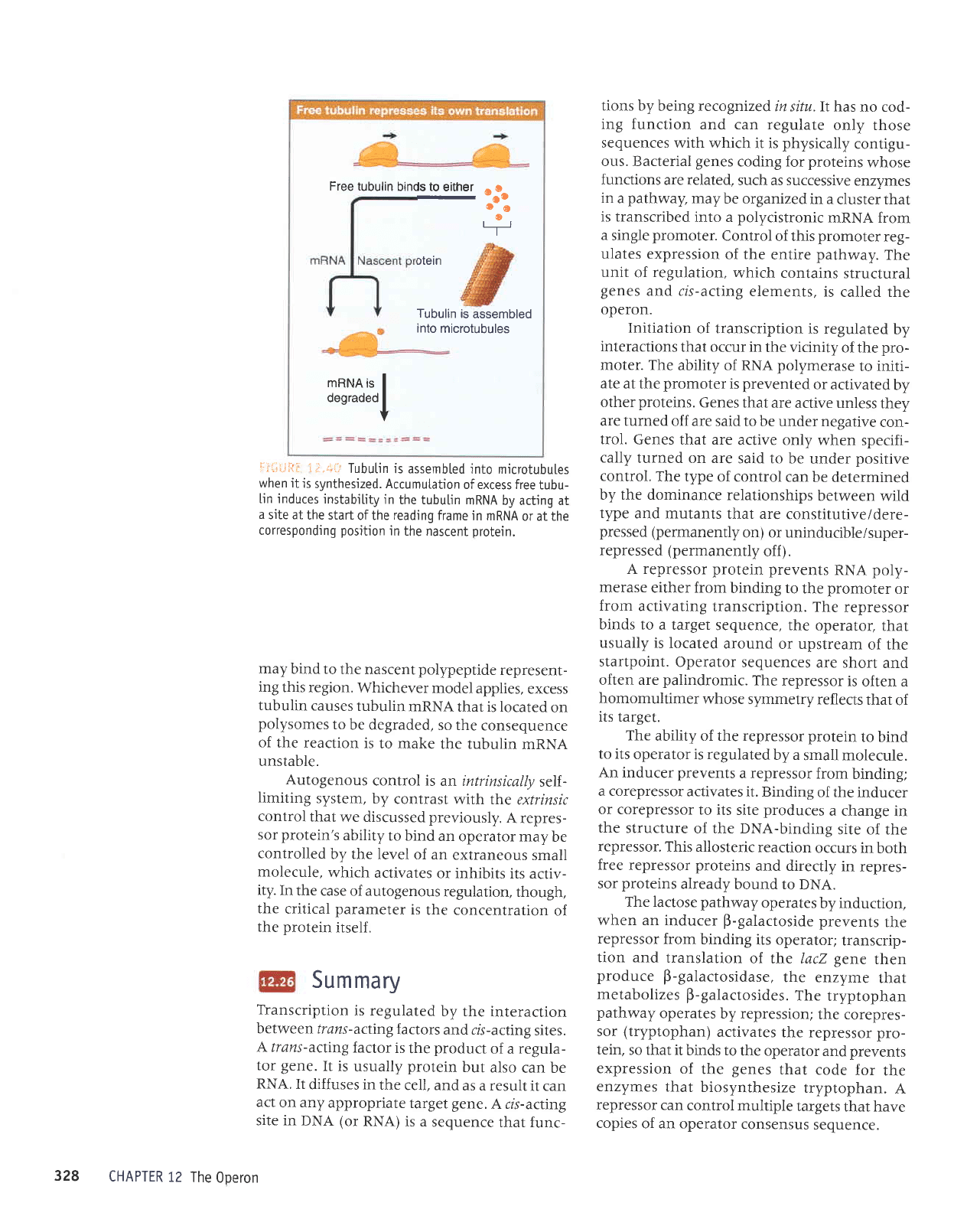
rs ro
erlner
^
o
--oo
O6
o
f
)tein
Tubulin
is
assembled
into
microtubules
nffif
Free tubulin
binds to
either
i-i*i":,1i i.i.+t
Tubutin
is assembted
into microtubuLes
when it
is
synthesized. Accumutation
of excess free
tubu-
[in induces
instabiLity
jn
the tubu[in
mRNA
by acting at
a
site at
the start
of the reading frame
jn
mRNA
or at the
corresponding
position
in
the nascent
protein.
may
bind to
the nascent
polypeptide
represent-
ing
this region.
Whichever
model
applies,
excess
tubulin
causes
tubulin
nRNA
that is located
on
polysomes
to
be degraded,
so the
consequence
of
the reaction
is
to make
the tubulin
mRNA
unstable.
Autogenous
control is
an intrinsically
self-
Iimiting
system,
by
contrast
with the
extrinsic
control
that
we discussed previously.
A repres-
sor
protein's
ability
to bind
an
operator may
be
controlled
by the level
of an
extraneous
small
molecule,
which
activates
or inhibits
its activ-
ity. In
the
case of autogenous
regulation,
though,
the
critical
parameter
is
the concentration
of
the
protein
itself.
Sum
mary
Transcription
is regulated
by the
interaction
b etwe
e n tr an
s
-
acling
f a ctors
and cli
-
a cting
sites.
A trans-acing
factor
is
the
product
of a
regula-
tor gene.
It is
usually
protein
but
also
can be
RNA.
It
diffuses in
the
cell, and
as a result
it can
act
on any
appropriate
target gene.
A cis-acting
site in
DNA
(or
RNA)
is a
sequence
that func-
CHAPTER
12
The
0peron
tions by
being recognized
in situ.It has
no cod-
ing function
and can regulate
only those
sequences with
which it is
physically
contigu-
ous. Bacterial
genes
coding for
proteins
whose
functions
are related,
such as successive
enzymes
in
a
pathway,
may
be organized
in a
cluster that
is transcribed
into a
polycistronic
mRNA from
a
single
promoter.
Control
of this
promoter
reg-
ulates expression
of the
entire
pathway.
The
unit
of
regulation,
which contains
structural
genes
and crs-acting
elements,
is
called the
operon.
Initiation
of transcription
is regulated
by
interactions
that occur in
the vicinity
of the
pro-
moter. The
ability
of
RNA
polymerase
to initi-
ate at the
promoter
is
prevented
or
activated
by
other
proteins.
Genes
that are
active unless
they
are turned
off are said to
be under negative
con-
trol.
Genes that are
active only
when
specifi-
cally
turned on are
said to
be under
positive
control.
The type
of control
can be
determined
by the dominance
relationships
between
wild
type
and mutants
that are
constitutive/dere-
pressed
(permanently
on) or uninducible/super-
repressed
(permanently
off).
A repressor protein prevents
RNA
poly-
merase
either from
binding to
the
promoter
or
from
activating
transcription.
The
repressor
binds to
a target
sequence, the
operator,
that
usually
is located
around
or upstream
of the
startpoint.
Operator
sequences
are short
and
often are
palindromic.
The
repressor
is
often a
homomultimer
whose
svmmetrv
reflects
that
of
its target.
The
ability of the repressor prorein
to bind
to its
operator is
regulated
by a
small molecule.
An inducer
prevents
a repressor
from
binding;
a corepressor
activates
it. Binding
of the
inducer
or corepressor
to its
site
produces
a change
in
rhe
strucrure
of the DNA-binding
site of the
repressor.
This allosteric
reaction
occurs in
both
free
repressor
proteins
and directly
in
repres-
sor
proteins
already
bound to
DNA.
The lactose
pathway
operates
by induction,
when an
inducer
B-galactoside
prevents
the
repressor
from
binding
its operator;
transcrip-
tion and
translation
of the lacZ
gene
then
produce
B-galactosidase,
the enzyme
that
metabolizes
p-galactosides.
The
tryptophan
pathway
operates
by repression;
the corepres-
sor
(tryptophan)
activates
the repressor pro-
tein,
so that it
binds to
the operator
and
prevents
expression
of
the
genes
that
code
for
the
enzymes
that
biosynthesize
tryptophan.
A
repressor
can
control
multiple
targets
that have
copies
of an operator
consensus
sequence.
328
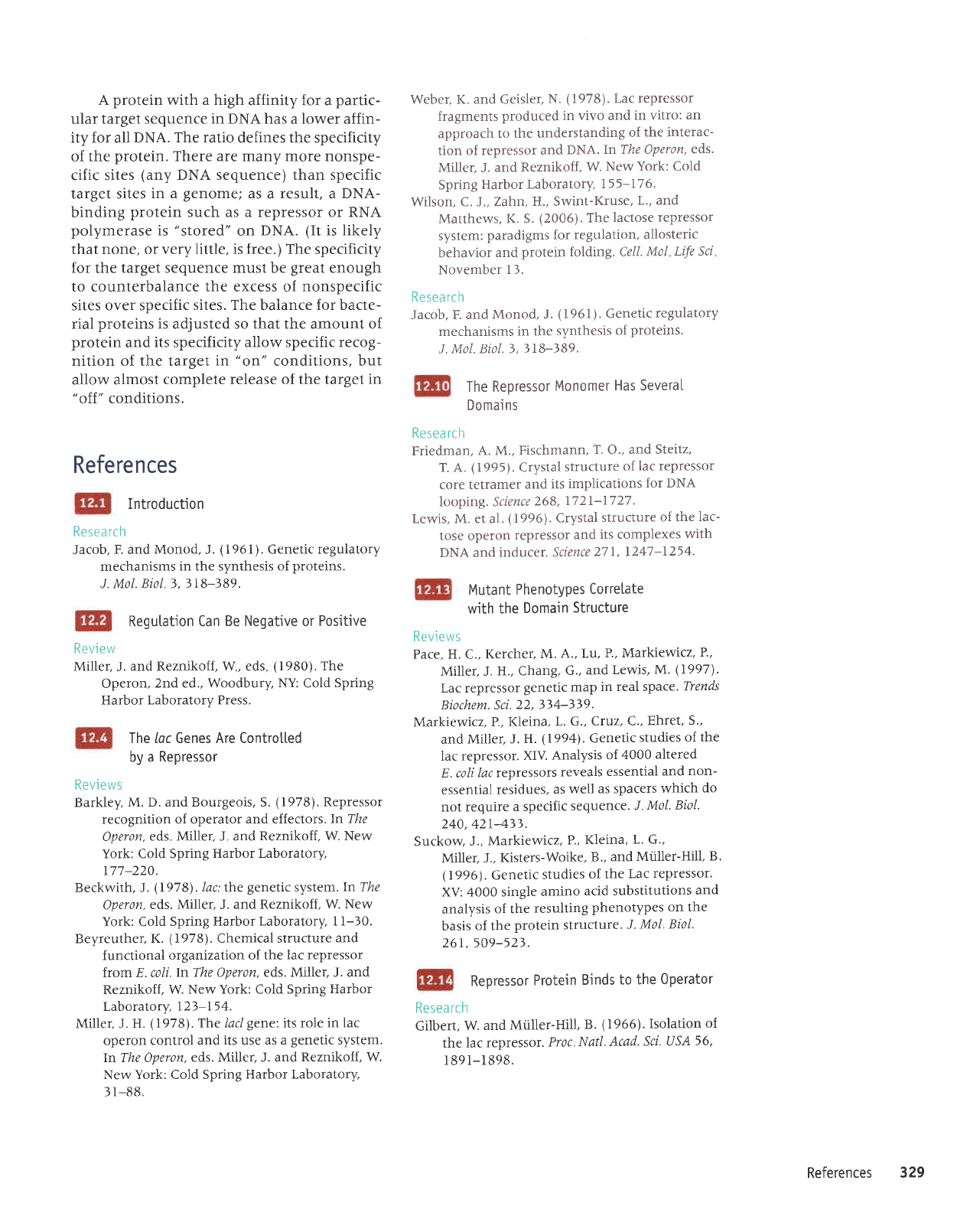
A
protein
with a high
affinity lor a
partic-
ular target sequence in DNA has a lower affin-
ity for all DNA.
The ratio
defines the specificity
of the
protein.
There are many more nonspe-
cific sites
(any
DNA sequence) than specific
target sites
in a
genome;
as a
result,
a
DNA-
binding
protein
such as a repressor or RNA
polymerase
is
"stored"
on
DNA.
(It
is likely
that none, or very
little,
is free.) The specificity
for
the
target sequence must be
great
enough
to counterbalance the excess of
nonspecific
sites over specific
sites. The
balance
for bacte-
rial
proteins
is adjusted so that the amount of
protein
and
its specificity allow specific recog-
nition of the target in
"on"
conditions, but
allow almost
complete release of the target
in
"off"
conditions.
References
Introduction
Resea rc
h
Jacob,
F. and
Monod,
J.
(
196 I
).
Genetic
regulatory
mechanisms
in
the synthesis
of
proteins.
J. Mol. Biol ),318-)89.
Regutation Can
Be Negative
or
Positive
Review
Miller, J.
and Reznikoff, W, eds
(1980).
The
Operon,
2nd ed., Woodbury, NY: Cold
Spring
Harbor
Laboratory Press.
The lac Genes Are Controtled
by a Repressor
Reviews
Barkley,
M. D. and Bourgeois, S.
(1978).
Repressor
recognition of operator
and effectors. In
Tfte
Operon,
e ds. Miller, J. and
Reznikoff,
W.
New
York: Cold Spring
Harbor Laboratory,
t77-220.
Beckwith,
J.
(1978).
lac:
Ihe
genetic
system. In
Tfte
Operon,
eds. Miller, J. and
Reznikoff, W. New
York: Cold
Spring Harbor
Laboratory, I I-30.
Beyreuther,
I(.
(1978).
Chemical structure
and
functional
organization of the
lac repressor
from E. coli.ln
The Operon, eds. Miller, J. and
Reznikoff, W. New
York: Cold Spring
Harbor
Laboratory,
123-154.
Miller, J.
H.
(I978).
The lacl
gene
: its role
in lac
operon
control and
its
use as
a
genetic
system.
ln The Operon,
eds. Miller, J. and
Reznikoff, W.
New
York: Cold Spring
Harbor Laboratory,
3
l-88.
Weber,
I(. and Geisler,
N.
(1978).
Lac repressor
fragments
produced in vivo and
in vitro:
an
approach to
the understanding
of
the interac-
tion
of repressor
and
DNA.
In The Operon,
eds.
Miller, J.
and Reznikoff,
W New
York: Cold
Spring
Harbor Laboratory,
155-17
6.
Wilson,
C. J., Zahn,
H., Swint-I(ruse,
L., and
Matthews,
K. S.
(2006).
The
lactose
repressor
system:
paradigms for
regulation,
allosteric
behavior
and
protein folding. Cell.
Mol
Life Sci
November
13.
Resea rc
h
Jacob,
F. and
Monod, J.
(
l96l
)
. Genetic
regulatory
mechanisms
in the
synthesis
of
proteins.
J.
Mol. Biol. ),
jl8-)89.
The Reoressor
Monomer
Has Several
Domains
Resea
rch
Friedman,
A. M., Fischmann,
T. O.,
and Steitz,
T. A.
(
1995). Crystal
structure
of
lac repressor
core tetramer
and
its
implications
for DNA
Iooping. Science
268,
17 2l-1727.
Lewis, M. et al
(
1996).
Crystal
structure
of the
lac-
tose operon
repressor
and
its complexes
with
DNA and
inducer.
Science
271,
1247-1254.
Mutant
PhenotYPes
Corretate
with
the
Domain
Structure
Reviews
Pace, H. C.,
I(ercher,
M.
A., Lu,
P., Markiewicz,
P.,
Miller, J.
H., Chang,
G.,
and
Lewis,
M'
(1997)r.
Lac repressor
genetic map in
real space.
Trends
Biochem. Sci.
22, 3)4-)J9.
Markiewicz,
P,
ICeina,
L. G.,
Cruz, C.,
Ehret,
S.,
and
Miller, J.
H.
(1994\
. Genetic
studies of
the
lac repressor.
XIV. Analysis
of
4000
altered
E. coli
lac repressors
reveals
essential
and
non-
essential
residues,
as
well
as spacers
which
do
not require
a specific
sequence.
J
Mol. Biol-
240, 42t-4)3.
Suckow,
J.,
Markiewicz,
P,
ICeina,
L. G.,
Miller, J.,
ICsters-Woike,
B.,
and Miiller-Hill.
B.
(19961.
Genetic
studies
of the
Lac
repressor.
XV: 4000 single
amino
acid substitutions
and
analysis
of the
resulting
phenotypes on the
basis
of the
protein structure.
J. Mol
Biol'
26r,509-123.
Repressor
Protein
Binds
to the
0perator
Resea
rch
Gilbert,
W.
and
Miiller-Hill,
B.
(I966). Isolation
of
the lac
repressor.
Proc
Natl
Acad.
Sci' USA
56'
I 89
l-l 898.
References
329
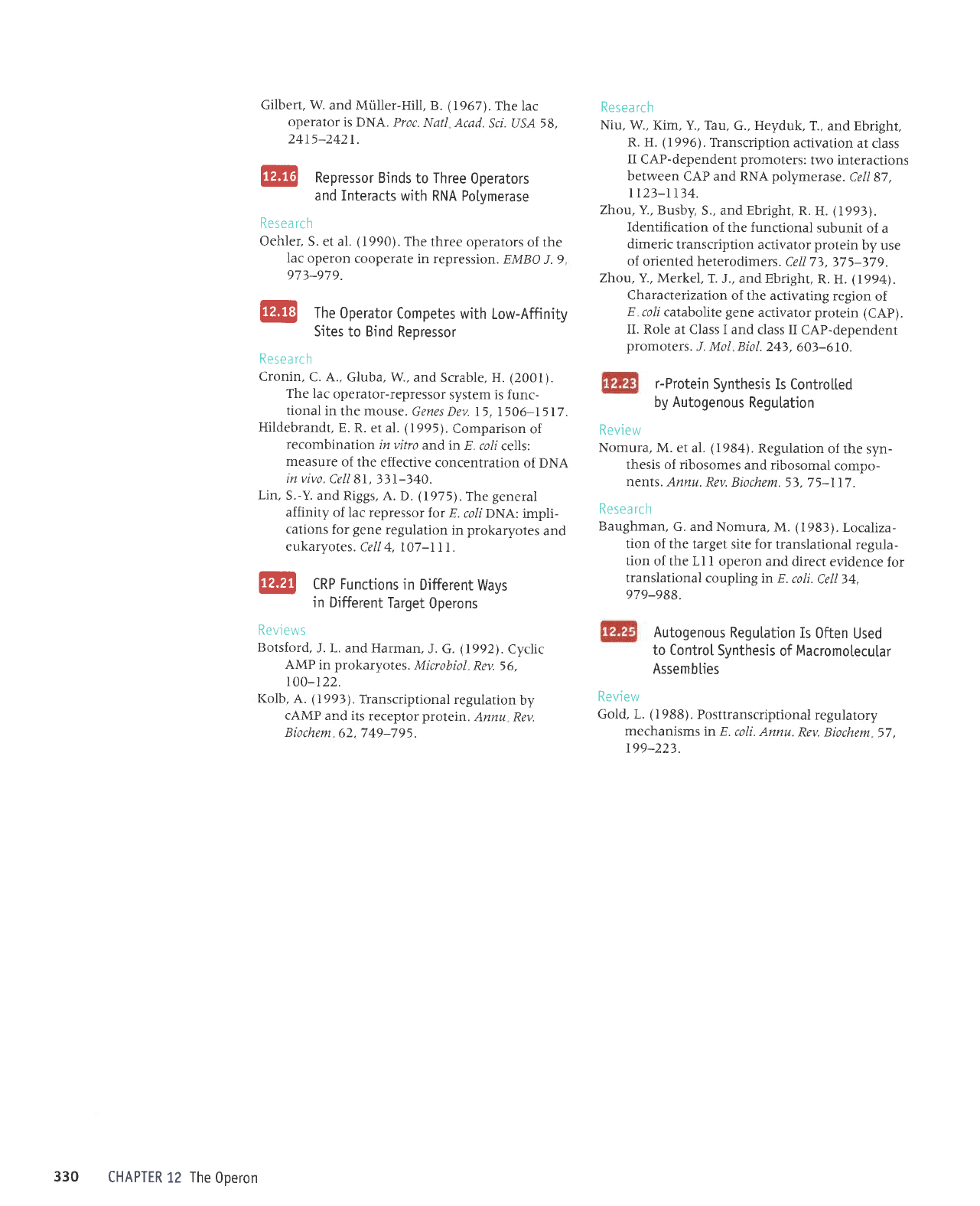
Gilbert, W.
and Mtiller-Hill,
B.
(1967).
The lac
operator
is DNA. Proc.
Natl Acad.
Sci.
USA 58,
24t5-2421.
@
Repressor
Binds
to
Three
0perators
and Interacts
with RNA Potymerase
Resea rc h
Oehler, S.
et al.
(1990).
The
three
operators
of the
lac
operon cooperate
in repression.
EMBO
J.9
97)-979.
@
The
0perator
Competes with
Low-Affinity
Sites
to
Bind
Repressor
Resea rc
h
Cronin,
C. A.,
Gluba, W., and
Scrable, H.
(2001).
The lac
operator-repressor
system is
func-
tional
in
the mouse .
Genes Dev. 15,
1506-1517.
Hildebrandt,
E.
R. er al.
(1995).
Comparison
of
recombination
in vitro
and in
E. coli
cells:
measure
of
the effective
concentration
of DNA
in vivo.
Cell 81,
,I-340.
Lin,
S.-Y.
and Riggs, A.
D.
(1975).
The
general
affinity
of lac repressor
for
E. coli DNA:
impli-
cations
for
gene
regulation
in
prokaryotes
and
eukarvotes.
Cell 4. 107-111.
@
CRP Functions
in
Different
ways
in Different
Target
Operons
Reviews
Botsford,
J. L. and Harman,
J. G.
(1992).
Cyclic
AMP
in
prokaryotes.
Mitobiol
Rev. 56,
t00-122.
I(olb, A.
(1993).
Transcriptional
regulation
by
cAMP and its
receptor
protein.
Annu Rev.
Biochem
62,749-795.
Researc h
Niu, W., Ifim, Y.,
Tau, G., Heyduk,
T.,
and
Ebright,
R. H.
(t
996). Tlanscription
activation
at class
II
CAP-dependent
promoters:
two interactions
between
CAP and RNA
polymerase.
Cell
87,
rr23-t134.
Zhou,Y.,
Busby,
S., and Ebright, R.
H.
(1993).
Identification
of the functional
subunit
of
a
dimeric
transcription
activator
protein
by use
of
oriented heterodimers.
CellT),
)75479.
Zhou, Y.,
Merkel, T.
J., and Ebright,
R. H.
(
1994)
.
Characterization
of the activating
region
of
E
coli catabolite
gene
activator
protein
(CAP).
II. Role
at Class I and
class II
CAP-dependent
promoters.
J. Mol Biol.243,
603-610.
r-Protein
Synthesis Is Controlted
by Autogenous
Regutation
Review
Nomura, M. et
al.
(1984).
Regulation
of the syn-
thesis of ribosomes
and ribosomal
compo-
nelf,ts. Annu.
Rev. Biochem.
53.75-ll7
.
Research
Baughman,
G. and
Nomura, M.
(1983).
Localiza-
tion of the
target site for
translational
regula-
tion
of the L I I
operon and
direct evidence
for
translational
coupling in E.
coli.
Cell )4,
979-988.
Autogenous
Regutation Is
0ften
Used
to ControI
Synthesis
of
Macromolecular
Assemb[ies
Review
Gold, L.
(1988).
Posttranscriptional
regulatory
mechanisms
in E.
coli. Annu.
Rev. Biochem
57.
199-223.
330
CHAPTER
12 The
0peron
